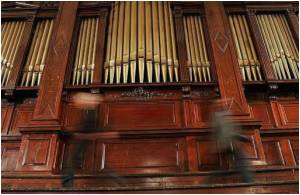A Swiss woman took the initiative to bring back music from majestic church organs in the medieval fortified churches of Transylvania that had fallen prey to rodents and the ravages of time.

And Baroque organ music has started to resound again in this region of central Romania.
"Transylvania is a very interesting region for historical instruments. I don't think you'll find anywhere else in Europe with as many instruments of this value and beauty that aren't in working order," Dutli told AFP.
The restoration project has even won the support of Britain's Prince Charles, a staunch promoter of Transylvania's rich heritage.
Last summer, he sent a message saying he "prayed with all his heart" for the successful restoration of the organ at Rupea village.
To breathe new life into these instruments built between the 17th and 19th centuries, Dutli becomes a detective trying to unearth the original construction plans and identify the materials used for the keys, pipes and wooden panels.
Advertisement
When she started work on the Rupea model last year, she could not immediately identify the builder. But after scrutinising the instrument's thousands of pieces, her heart began to pound when she spotted a date written on the sheepskin of the bellows: 1699.
Advertisement
Beside her, sitting above the bellows, celebrated organist Steffen Schlandt is rehearsing "with great emotion" on this historical instrument that seemed doomed to decay just a few years ago.
To restore the keys Schlandt is playing, Dutli had to look all over Europe to find a plank carved from the root of a walnut tree.
The 700 pipes -- ranging in height from a few centimetres to more than two metres (six feet) -- were either restored or replaced according to methods used by craftsmen in the 17th century.
"I shape them on the sand," Magyar Arpad says proudly as he applied the technique of casting flat sheets of alloys on a special sand bench. The 29-year-old ethnic Hungarian from Romania learned organ-building in a workshop Dutli set up here in Harman, a village in the heart of Transylvania.
Dutli, born in the Zurich area, first began coming to Romania in the 1990s, just after the fall of the brutal dictatorship of Nicolae Ceausescu, to help restore organs during her holidays.
Under the Communist regime, religion was banned and the craft of organ-building disappeared.
Fascinated by the region, she settled in Romania and set up a training centre for restorers in 2003 with the help of the Swiss Foundation for Organs in Romania.
"We want to train a new generation of Romanians to build and restore the organs of their country," Dutli says.
Students follow a three-year training programme, combining theory and practice under the guidance of Swiss maestros. They are also taught cabinet-making to broaden their chances on the labour market.
"What is really good is that we learn a craft that will be very useful in the future. There are so many organs to be restored that I think even my grandchildren will have work," 22-year-old apprentice Lorincz Konrad Leher told AFP.
It is a unique opportunity in a country from which more than three million people have emigrated to find work.
Only about one-fifth of Transylvania's approximately 250 organs have been restored so far, according to Kurt Philippi, an ethnic Saxon musicologist who has unearthed century-old music scores for organs.
"Saving the organs is like saving a part of our culture and identity," he said, recalling the tragic fate of his community.
The Saxons settled in Transylvania in the 12th century when King Geza II of Hungary sought their help to defend the eastern border of the kingdom from Tatars and Turks.
They lived and prospered for centuries until World War II when many were enlisted, sometimes against their will, in the Wehrmacht because of their German ancestry.
After Soviet troops entered Romania in 1944, tens of thousands of Saxons were deported to labour camps in Siberia.
For decades under the Communist regime, Saxons were unable to leave Romania; they fled en masse to Germany after the fall of Ceausescu.
Romania's ethnic Germans including Saxons numbered more than 630,000 in 1930; by 2002 there were fewer than 60,000 according to the latest available census figures.
Today the fortified churches built by their forefathers and listed by UNESCO as World Heritage -- as well as organs with their intricate linden-tree ornaments -- remain as their legacy.
Dutli hopes to save more of these masterpieces: "What is fascinating is to transform dead materials -- wood, metal, animal skin -- into something that produces great music."
Source-AFP









